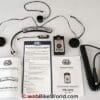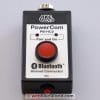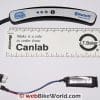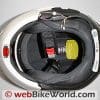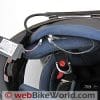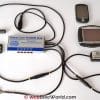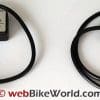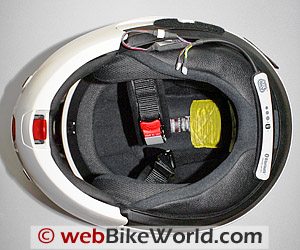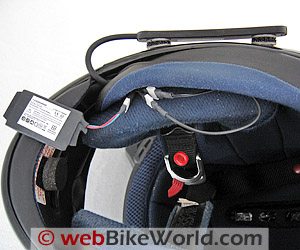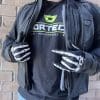Isn’t Technology Great?
This section continues the ROGER One evaluation, but with some very tangible differences. With a companion PowerCom Bluetooth Headset on hand, along with other optional goodies, and driven by curiosity, this foray into wireless and mixed environments was inevitable.
In This Series:
-
Part 1: AKE PowerCom ROGER One Motorcycle Communications and Intercom
-
Part 4: Motorcycle Communications Using the AKE PowerCom INNOVA System
The information and assessments presented are based on both documented and undocumented features, all of which were identified and validated for the overall ROGER One evaluation. As eluded to in Part 1, with the right accessories and patience, functionality of the basic system can be enhanced quite simply.
AKE PowerCom Bluetooth Helmet Set 101 and PB-HC2 Bundle
Bluetooth has provided a simple technology-based solution to provide “fit-for-motorcycle handling” (interfacing) of Bluetooth mobile phones and Bluetooth GPS, thus extending the functionality and versatility of not only the ROGER One system, but all PowerCom systems.
This AKE solution is now bundled in one kit comprising the Bluetooth Helmet Set and a companion Bluetooth module, the PB-HC2. All components are extremely low profile and depending on the type of helmet to be used, can be mounted under the neckpiece or between the shell and liner material, rendering the whole setup virtually invisible.
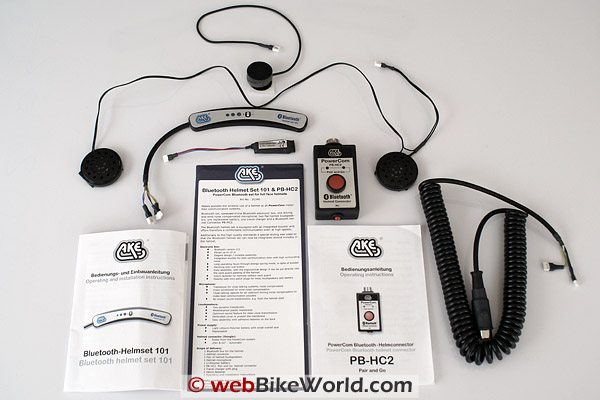
Environments
The Bluetooth Helmet Set 101 is a stand-alone headset that can be interfaced to virtually any other Bluetooth peripheral or device that might be available, providing a completely wireless system.
However, adding the optional PB-HC2 Bluetooth module provides a wireless link to the ROGER One control module, allowing a mix of wired or wireless devices and thus the best of both worlds. It is a cost effective means to enhance and tailor the basic system.
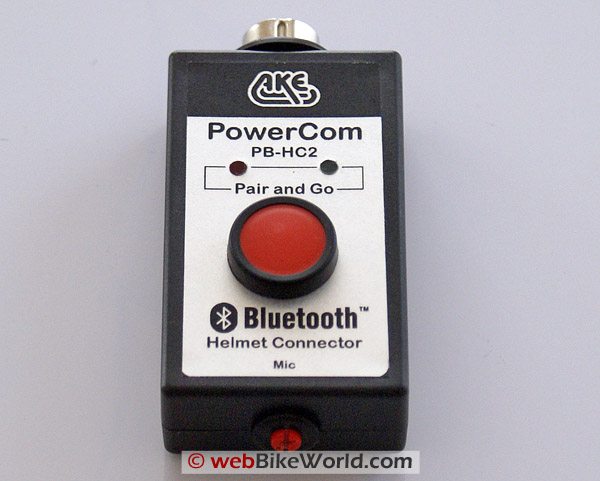
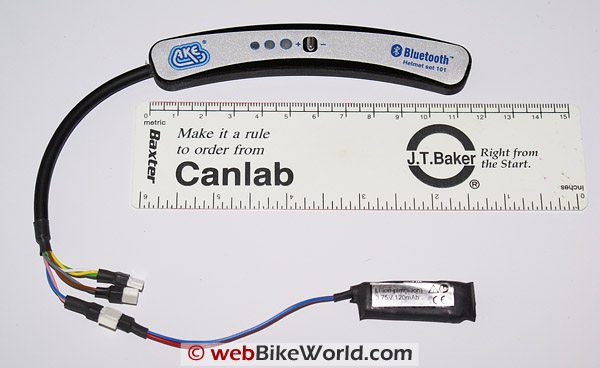
Fitting the Kit
The bundle contains a stylish and slim 18 x 116 x 6 mm and light (21 grams) Bluetooth module with integrated booster, the PB-HC2 Bluetooth dongle, a set of helmet speakers similar to the HighVoice components (300 to 5,000Hz), a round vice rectangular wind noise compensated microphone, one replaceable battery module and a 100-240V travel charger, with a 220v plug.
A short set of installation and operating instructions in German and English is provided, along with a Velcro fastener for mounting the microphone and some small cable ties. For initial evaluation, the kit was installed in a black Arai Corsair and for riding it was installed in the Nolan 102 Flip helmet.
Although the module is designed to fit up under the neckpiece of a helmet with the control button accessed by feel or pressure, it introduces some guesswork in manipulating the control, especially through any liner material. While not impossible, it could be difficult and many helmet neckpieces would not be flexible enough to accommodate the pieces.
Alternatively, as the module is unobtrusive and seemingly sealed to withstand the elements, it was mounted on the left side just above the neckpiece, secured on the soft plastic trim using two round hook-n-loop fasteners. This worked well in that it provided about 5mm of clearance between the two surfaces, providing both vibration protection, and keeping it accessible.
Power is provided by the standard rechargeable 120mAh Li-ion battery. This battery module measures a diminutive 40 x 15 mm (1.5 x ½ in) and is connected to the main module by a two pin flat mini-connector, all of which is easily tucked out of sight under the neck liner.
The optional high-power battery, rated at 750mAh, is larger at 60 x 30 mm (1.25 x 2.25 in). On the Arai RX-7 Corsair helmet, the larger battery module could be squeezed up under the neck liner and secured in place with a Velcro hook tab. On other helmets, it might have to be secured on a bottom edge or on the shell.
Key to this whole wireless thing is the PB-HC2 Bluetooth Pair-and-Go module that plugs into the DIN (F) plug, replacing the wired connection to the headset. This Bluetooth dongle has a not-to-be-missed red button, two small LEDs, RED and GREEN and a microphone adjustment trimmer on the bottom end.
The Master Pairing
AKE states the Bluetooth Helmet Set 101 and bundled PB-HC2 dongle are delivered ‘paired’, which they were. Turning on the 101 headset first, then the control module sets the two units into a brief introductory session. After fifteen seconds, the LED on both units blinked their respective ‘paired’ message, indicating that a link has been established.
Inside the helmet, a short squelch-like tone was heard, verifying that the system was live, followed by a short multi-tone sequence, confirming a complete system. A quick verification of system functionality was done using one of the radio devices. Figuratively, the cord was now cut.
Configurations Challenges
To say that a lot of different configurations were tried and documented would be an understatement. Both documented and undocumented features were evaluated, the objective being to validate basic functions and take a building block approach to enhancing system functionality.
The initial configurations identified below are based on use of the Bluetooth headset and specific Bluetooth enabled devices, on a one to one pairing or more complex (multiple pairing) arrangements using the ROGER One system with a Bluetooth module, the PowerCom Bluetooth Helmet Set 101 and, other Bluetooth headsets.
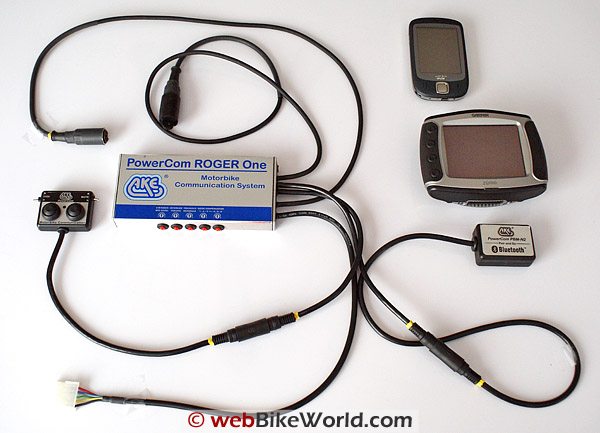
Bluetooth Helmet Set 101 and Garmin zumo 550 GPS
Pairing with the control module accomplished, it was time to see how the headset, as a stand-alone system, would perform using Bluetooth peripherals. Following the instructions, the helmet set was powered down and restarted by holding the control button for about six seconds, putting the device directly into the learn mode. The LED will flash a rapid red and blue.
With the zumo Bluetooth pairing mode activated, it only took fifteen seconds before the headset was found and identified as a 3xxx Plantronics (Chipset used). Connection accepted, the security protocols were initiated (no pass code was required for this pairing) and the link secured. Once done, audio generated by the zumo unit was almost instantly received in the headset.
Before moving off the zumo Bluetooth menu, this connection was named HS101BT and saved. This is a recommended procedure in any case, as it allows the helmet set or other devices as named to be readily identified and paired up with the zumo in future.
With this connection made, the zumo’s MP3 player was activated, sending mono audio via Bluetooth to the headset. Despite the omnipresent white noise on the connection the audio is of very good quality: the stereo headset provide a nicely centred listening environment within the helmet.
Considering that the audio being streamed via Bluetooth is mono, the difference between the HighVoice and the HighSound headsets is very evident — HighSound audio is much clearer and even bass effects can be felt.
A volume setting of 20 to 40 percent on the zumo menu was typically more than enough for comfortable listening inside the helmet, depending on noise levels. Volume of the helmet set can also be adjusted by pushing the main control toggle forward (+) or backwards (-), although volume range is very limited.
As with most Bluetooth devices, when the connection is lost, or broken for whatever reason, one or both of the devices may need to be restarted or the connection re-initialized so they will pair up again. It was found that with the zumo, using the ‘restore’ button usually re-established the connection to the helmet at any time, a nice feature.
When a connection or pairing is present, the helmet set module LED pulses blue about every five seconds. To turn the module off, hold the control button in for about five seconds – the LED will flash RED and then a steady RED, following by the unit powering down, with a confirmatory beep heard inside the helmet.
Bluetooth Helmet Set 101 and HTC Touch PDA
An HTC Touch PDA was next up. Compared to the three year old device it replaces, this one is pretty sophisticated. With typical PDA software, voice control, Bluetooth v2.0, and A2DP capable, it is a very nice toy…er, tool. Being able to access email and other data services as needed (for a fee of course) is a good option, especially on long trips.
As no compatible interface cable was available for the HTC device, a simple one to one Bluetooth connection with the headset was initiated. Pairing was quick and the helmet headset subsequently configured as a hands-free partnership and saved off as HTC Touch.
With this pairing, calls could be received from the HTC via the headset or manually initiated. Answering or terminating the calls was done by simply tapping the main control button on the headset module, or manually terminating the call on the HTC.
Bluetooth Helmet Set with zumo 550 and HTC Touch PDA
As the headset had been paired previously to the zumo 550, this pairing was re-initiated. While listening to music from the zumo, a new device pairing was initiated from the ‘Connect Phone’ menu on the zumo 550 and under the Bluetooth menu of the HTC.
The zumo 550 was found on the first pass by the HTC and with the appropriate pass code entered (as offered up by the zumo), a phone link was made. The zumo 550 also presents a message stating “ready to make phone calls”.
Pushing the phone icon on the zumo to initiate the phone menu allowed calls to be initiated. An incoming call will activate the pop-up phone screen so that the call can be rejected or received. Switching was fast, and audio clarity was excellent. Both the rider and the intercom user were able to participate in the sessions.
ROGER One with Bluetooth Modules, Bluetooth Helmet Set, zumo 550 and HTC Touch
Having validated the basic one to one pairing requirements between the Bluetooth Helmet and Bluetooth peripherals, it was time to re-introduce the main player, the ROGER One, back into the equation.
As well, the chance to evaluate two other optional Bluetooth modules to verify just what the ROGER one could, and would accommodate was not to be ignored.
The start state for this activity had the ROGER One with PowerCom Operating device plugged in to the ‘R” lead for manual control and the intercom user plugged in to the system. The headset connections in the Nolan 102 Flip helmet that the rider was using were switched over to the Bluetooth Helmet Set, an action that takes about 30 seconds, it is that simple.
Before initiating the Bluetooth, a little house-cleaning was in order so as to keep previous connections from offering up their services, before being wanted. After clearing all connections on the zumo 550 and the HTC Touch devices, they were both turned off and then on, as was the Bluetooth Helmet set.
With the rider lead disconnected, the PB-HC2 module was inserted in its place. The green LED on the PB-HC2 module flashed once a second, indicating search mode. Within ten seconds the control welcome tone sequence was heard in the headset, step one done. When paired, the Bluetooth module Green LED remains on, while the RED LED pulses slowly.
Step two was a quick radio check, using both the iVOX and PTT settings on the PowerCom operating device, just to confirm that everything was working well. If connected, the intercom is an omnipresent feature with the rider once a link is in place.
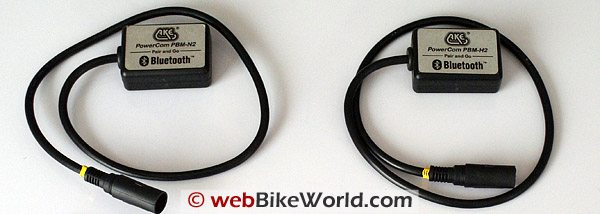
PBM-N2 and PBM-H2 Modules
These two little Bluetooth modules are the keys to expanding the ROGER One world. While AKE states that these components should work with all PowerCom modules, they have only been documented for use with the AKE CONNECT, ON TOUR or INNOVA units. Getting them working with the Roger One would put us in a somewhat undocumented feature territory.
The first of two AKE PowerCom Bluetooth modules, the PBM-N2 module DIN ‘N’ connector was mated to the DIN ‘F’ plug of the control module. This module is identified for use as a means to add Bluetooth navigation (GPS) capabilities to an enabled system.
The desire to get this working was strong. If the zumo could be added successfully, then it would be able to host the HTC Touch, thus adding a mobile phone capability to the configuration, a specific target for this evaluation.
With the module connected, two tones are heard. The first indicates start-up, the second that it is ready for pairing (lasting two minutes). With the zumo 550 in discovery mode the module was found immediately, again identified as a 3xxPlantronics device. When accepted, the link was made, with an audio link created (almost) immediately.
Before moving on to the second module, some nearby wood was touched, and the HTC Touch configuration process was started (see note below). The ‘connect phone’ menu on the zumo provided the search mode and the two devices found each other. With the required pass code (as supplied on the zumo screen) entered into the HTC, a link was established — so far, so good.
Now a quick frown — the zumo keeps saying that the link has failed, this typically happens two or three times, in a row. However, again typically, it will come back and say “ready to make phone calls’, which it is. Hopefully the lag is just due to processing loads. AKE identifies that this might happen with some systems, a good note.
Several phone calls were initiated and received by using the zumo phone menu or icon. Once a number was put into the call-book, dialing was fast and connections made quickly. Audio sessions in the wireless headset were almost as clear as in the wired intercom user headset.
Note: if problems are encountered in pairing phones, it is sometimes better (and recommended by some manufacturers) to pair the phone to the host (GPS) device first and get that one to one configuration addressed. In any case, it is a workaround that usually works.
In this four-way configuration, the primary PB-HC2 module can be used to provide a measure of control: pressing the RED button will terminate its Bluetooth connection and if the power harness has been installed correctly, this action also powers down the control module.
When turned back on, both lights will flash to indicate search mode, then the Green LED should flash and then go steady, with the link re-established, typically within 10 to 15 seconds. It is all very simple and very effective.
The PBM-H2 module proved a bit more problematic. This module is intended to be used with either Bluetooth navigation or mobile phone devices. Plugged into the ‘F’ lead, it took three pairing attempts before a good connection was made and then, on the third pass, a pass code (0000) had to be entered into the zumo before the link was secured.
Other than this issue, likely related to its possible use with a mobile phone, most of which are pretty rigid in having a pass code provided before a ‘secure’ link is established, all zumo and phone functions enabled under the PBM-N2 were available with the PBM-H2 module as well.
Note: it was found that with configurations using the PBM-H2 module and with the operating device connected, the iVOX could not be used, necessitating PTT button use.
Audio Priority Management
The PowerCom ROGER One does not have active signal (audio) management given its single device connection. However for the rider and intercom user audio signal management was still provided by the attached Bluetooth device which does have audio priority management.
Lower priority audio (i.e., music) is instantly muted when any telephone session is initiated and then restored a few seconds after the higher priority session is terminated.
Connection Restoration
Never leaving a good thing untouched, the Roger One Bluetooth module (PB-HC2) was pulled out and then plugged back in after a few minutes — the connection was re-established in six seconds. Turning the module off and then on resulted in an eight second delay — sweet! This stuff really works.
In general it was found that the PBM-H2 module would typically restore itself when unplugged or if dropped under the zumo menu, whereas the PBM-N2 would typically, but not always, require a new pairing sequence to get it back into the loop.
Headset Battery Life
The standard 120mAh battery is claimed to be good for up to four hours of continuous music or eight hours of navigation voice announcement or 150 hours of stand-by. Of course, all of this will vary by individual operating environments.
Use revealed that the standard battery is good for about 2.5 to 3.0 hours of mixed voice, GPS and music streaming use. No doubt it would last longer if just used for a single purpose. The larger unit typically ran for about 7.5 to 8.5 hours under the same mixed load. Discharged, the standard battery took about 90 minutes to refresh itself and the larger unit about 4.5 hours.
The battery is recharged by connecting the charger ‘jack’ into the plug on the end of the module: the main LED glows red when it is charging. Care must be taken however as the snap-button style connection is easily dislodged. Being disappointed the next morning is a distinct possibility.
The ROGER One and Other Bluetooth Headsets
AKE states that the PowerCom Bluetooth Helmet Connector PB-HC2 is compatible with other Bluetooth helmet headsets as long as they are working with Bluetooth headset protocols. As both the scala-rider Q2 and the Interphone Bluetooth headsets were at hand, it was only prudent to see if the claim would hold up.
ROGER One and scala-rider Q2 Bluetooth Headset
With the ROGER One powered up, the PB-HC2 module is plugged into the rider ‘F’ lead with a power click verifying connectivity (the intercom was connected by cable so that all ROGER One proceedings could be monitored).
Following the instructions, hold the Red button down for ten seconds or more- the two LEDs will (eventually) alternate, indicating pairing mode. At the same time, the Scala Rider Q2 (review) is put into pairing mode. After about 30 seconds, both lights will pulse on the PB-HC2, then the Green LED will become steady and the Red LED will pulse, indicating a link.
On the scala-rider Q2, a double blue flash every three seconds will indicate that a session is being initiated. To make the actual connection, tap the CTRL button. A multi-tone sequence will be heard in the scala-rider Q2 headset and with another single tap to the CTRL button, the connection between the Bluetooth headset and the ROGER One will be live, with the intercom user automatically in the loop.
Interphone Bluetooth Headset
The baseline for this activity was the same, except the Interphone headset was turned off to start. The Interphone Bluetooth Intercom (review) is put into its pairing mode by shutting the unit off, then holding the single main control down for about six seconds, the LED will flash an alternating RED and Blue. At the same time, the PB-HC2 module is put into pairing mode.
This pairing was fast, taking only five seconds. To make the pairing ‘live’, the Interphone control was pushed once, which results in a series of four beeps and then a single, possible confirmation, tone. Once done, this headset is connected to the ROGER One – that was easy!
Powering down, or dropping the connections, restoration is fast, a few seconds of letting the two devices communicate, and one push on the Interphone control button, typically followed by a double-tone, re-establishes the whole link to the ROGER One.
Ad-Hoc: Roger One, PB-HC2 Bluetooth Module, Interphone, zumo and HTC
With the HTC Touch paired to the zumo 550, the ROGER One PB-HC2 connection to the Interphone Headset via Bluetooth was re-established. This was done by simply powering-up the Interphone first, then the PB-HC2 – the link was re-established automatically.
The PBM-N2 module was plugged in to the ROGER One system and when it was ready for pairing, the zumo pairing mode was initiated. A link was made immediately, with the audio from the zumo heard in the Interphone headset via Bluetooth and as well in the wired intercom headset.
In this configuration, phone calls could be answered, with some perceptible lag, by pressing the Interphone button once. However calls could not be ended or rejected this way. Using the zumo phone menu provided all functions.
GPS Device Use
For the record, both the Garmin Zumo 550, one on version 3.90 and one on version 4.0 were used, along with a BMW Navigator III+. In general, the zumo on version 4.0 worked flawlessly, while the zumo with version 3.90 exhibited ‘issues’ from time to time.
The Navigator would work well in a one to one pairing, but it did not like a more complex environment, although this could be related to firmware versions or something else not yet defined.
Conclusion: Part Two
The wireless or mixed environment environments are almost as quiet as the completely wired world. The usual white noise encountered on most RF connections is omnipresent but never obtrusive and becomes part of the operating environment.
Main (PB-HC2) or secondary (PBM-H2/PBM-N2) Bluetooth connections are established or re-established quickly – the lack of a physical tether between control module, helmet and all other devices, initially somewhat disconcerting, quickly becomes familiar and easy to live with.
Note: As expected configuring the scala-rider Q2 and Interphone Bluetooth headsets to pair with the ROGER One Bluetooth module ‘broke’ existing Buddy or pairing configurations that might have existed with a second Interphone, or second and third scala-rider Q2. But with the primary ROGER One Bluetooth module turned off, both systems searched for and found previous pairings with other like devices.
In one instance (not reproduced) the scala-rider Q2 acting as the ROGER One headset via Bluetooth actually initiated a search for its partner that had intentionally been brought in to close range. For a few seconds, a link was made, but then lost…a shame. More playing is obviously needed…
Based on the success in interfacing other Bluetooth devices and headsets, and perhaps sounding like a broken record (you know, those black spinning things), the fact remains that wired, wireless or in a mixed environment, the AKE PowerCom equipment, wired and/or wireless just plain works.
- Simple design, rugged components, weatherproof cables and connections.
- Major components and accessories can be interchanged between PowerCom systems.
- Interchangeable and interoperable components and accessories.
- Versatility: a host of undocumented features adds options.
- Lead connections are weatherproof and easy to use with gloves.
- Small component connectors are solid and foolproof to use (keyed connectors).
- Functionality. Everything works as advertised.
- Bluetooth functionality is the best ever used; pairings are fast and fail-proof.
- Wired/wireless options provide optimum versatility and flexibility.
- Excellent audio quality and oustanding with the HighSound speakers.
- Button connector too easily disconnected.
- Bluetooth module construction.
- No North American electrical plug.
Owner Comments and Feedback
See details on submitting comments.


